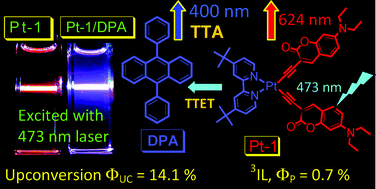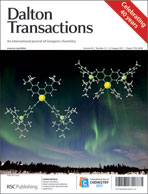A dbbpy platinum(II) bis(coumarin acetylide) complex (Pt-1, dbbpy = 4,4′-di-tert-butyl-2,2′-bipyridine) was prepared. Pt-1 shows intense absorption in the visible region (λabs = 412 nm, ε = 3.23 × 104 M−1 cm−1) compared to the model complex dbbpy Pt(II) bis(phenylacetylide) (Pt-2, λabs = 424 nm, ε = 8.8 × 103 M−1 cm−1). Room temperature phosphorescence was observed for Pt-1 (3IL, τP = 2.52 μs, λem = 624 nm, ΦP = 2.6%) and the emissive triplet excited state was assigned as mainly intraligand triplet excited state (3IL), proved by 77 K steady state emission, nanosecond time-resolved transient absorption spectroscopy and DFT calculations. Complex Pt-1 was used for phosphorescent oxygen sensing and the sensitivity (Stern–Volmer quenching constant KSV = 0.012 Torr−1) is 12-fold of the model complex Pt-2 (KSV = 0.001 Torr−1). Pt-1 was also used as triplet sensitizer for triplet–triplet-annihilation based upconversion, upconversion quantum yield ΦUC up to 14.1% was observed, vs. 8.9% for the model complex Pt-2.

You have access to this article
 Please wait while we load your content...
Something went wrong. Try again?
Please wait while we load your content...
Something went wrong. Try again?


 Please wait while we load your content...
Please wait while we load your content...